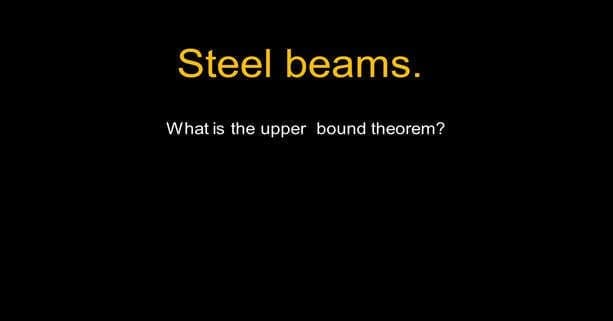Introduction to upper bound definitions.
A new subject to be discussed is the Upper bound and lower bound.
In our previous example, we have a beam fixed at one end at support A and roller support at point B, with a load acting at point C at the mid-span, the load value is 32λ, where λ= collapse load/working load. We want to estimate λ, to get the value of Pp for a beam with a length= 1.0 m.
We can get the value of λ by using statics.
We have two hinges at the collapse, one at joint A and the other one at joint C if we Consider the beam at the right sketch With a load of 32λ. We have a reaction value at joint A RA=16λ and a reaction value at joint B RB=16λ. We have moment Mp at joint A, which is the plastic moment value. Mp=9.0 KN.m.
The moment causes additional reactions at Joint A and B, Rb=9.0 KN acting downwards. While RA=9KN, acting upwards.
Taking the moment at C, we know that we have a value Mp at C at both sides, acting, against each other.
If we consider the moment at C estimated from the right support, we should have a value of 9.0 KN.m acting in the anti-clockwise direction, we have a moment=16λ*(0.50) from the reaction at B -9*0.50=9.0 KN.m, 8λ=9+4.50=13.50. λ=13.50/9=1.6875, this is the same value obtained from the previous video.
Now consider substituting by the value of λ, the total load= 32*λ=32*1.6875, the values of reactions are to be estimated, then estimate the moment at c. We should get the same value of 9.00 KN.m on both sides of C.
RA=0.50*(32)*1.6875=27.0 KN=Rb. While the reaction from the moment Mp of 9.0 KN.m at A, RA=9/1.00=9 KN acting upwards.
RA0.50-Mp=(27+9)0.50-9.00 =360.50-9.0=9.0 KN.M acting in the clockwise direction. While from the right side, we have Mc=(27-9)0.50=9.00 KN.M acting in the anti-clockwise direction.
At the joint, the assumption that it is a plastic joint is correct.
The Upper bound theorem.
In the virtual work method, we assume a point, for which, we equate the external work and the internal work at that point, but that point we assume is our chosen point, but maybe somebody else selects a different point and then gets another value of λ for this method, the upper bound theorem.
I quote, if a bending moment diagram is, found that satisfies the equilibrium and the mechanism (but not necessarily yield), what is meant by yield is that we could obtain a higher value than the plastic moment.
The corresponding load factor is either greater than or equal to the true load factor at collapse. A question, will be asked, which is the correct point that will give the exact value of Mp?
This method is called the unsafe theorem because, for an arbitrarily assumed mechanism, the load factor is either exactly right or wrong, that is why it is called the upper bound method. If the collapse loads are determined for all the possible mechanisms, then the actual collapse load will be the lowest of these (upper bound theorem). For the static load method, select the point That gives the highest value of Mp.
The difference between static theorem and Kinematic theorem.
This graph will explain the differences between static theorem and kinematic theory if the load or the moment Whether Pp or Mp. This horizontal line is the bound or the actual load represented by F at the collapse.
Using the kinematic method will lead to values that are either equal to the actual plastic load or higher values than the plastic load.
The static theorem, where we overlap the two moments together select the maximum value of M, and let it equal Mp, will lead to a value lower than or equal to the plastic loads or moments. The bound is the actual value, the kinematic theorem is the upper bound of collapse, and the static theorem gives a lower graph at points B, and C, or matches the graph at point D.
This is the pdf file used in the illustration of this post and the next post.
For useful information about the structural analysis -III.
For the next post, Step-by-step introduction to lower bound and uniqueness.

